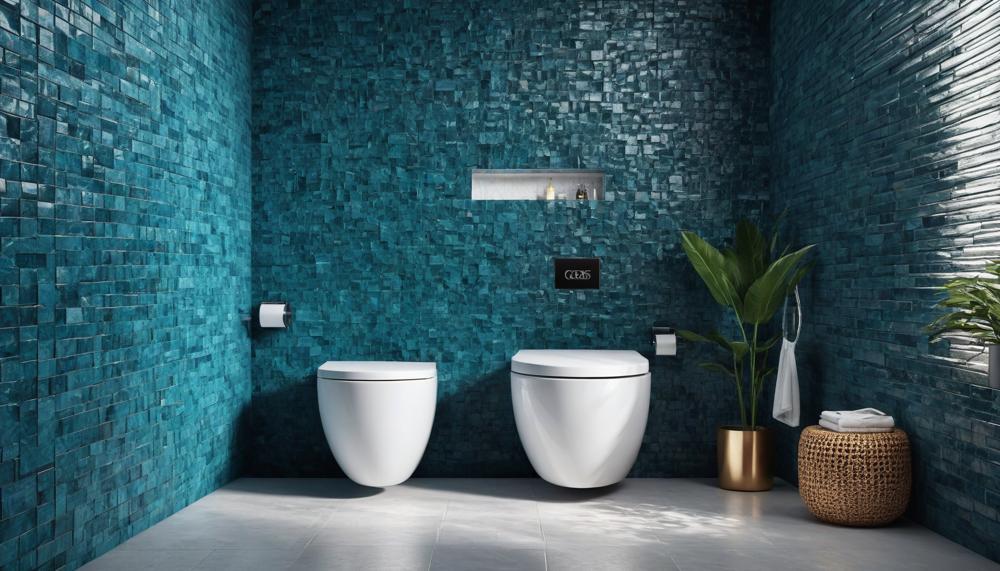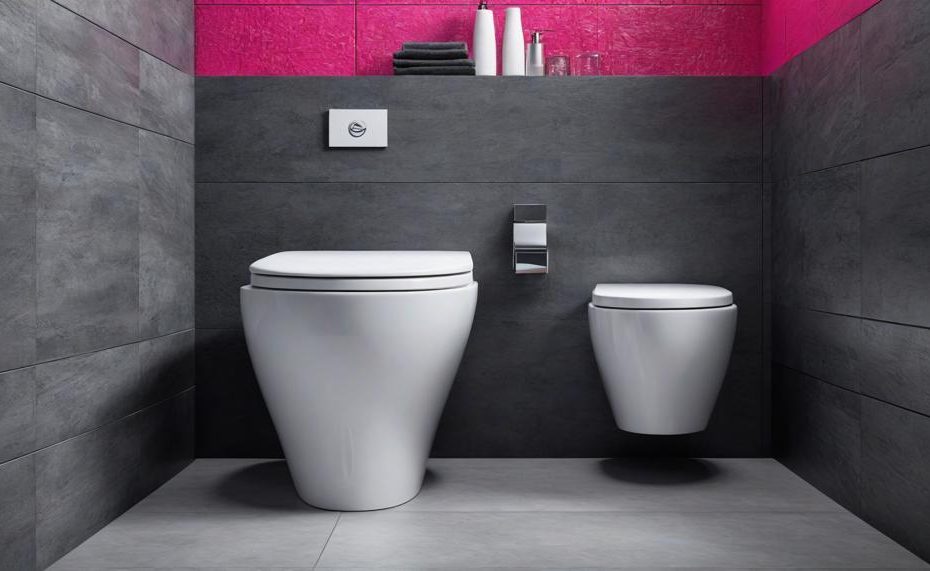Have you ever noticed a pesky gap between your toilet and the wall? It might seem like a minor issue, but it can affect the overall stability and appearance of your bathroom. Building codes recommend a 1-2 inch gap between the toilet tank and the wall, but sometimes toilets are installed too far away, creating a more significant gap that needs fixing. The good news is that this problem can be tackled with a few straightforward solutions.
Whether you’re dealing with an older home with modern plumbing systems or just trying to achieve a seamless look, addressing this gap can make a big difference. From using an offset flange to installing securing braces, we’ve got practical tips to help you fix that gap and ensure your toilet is both secure and aesthetically pleasing. Let’s dive into the key takeaways so you can get started on making your bathroom perfect:
Key Takeaways:
- Offset Flange: Adjusts the distance between the toilet and the wall, providing stability and preventing leaks.
- Relocating Plumbing: For larger gaps, professionals may need to move the plumbing system, which can cost between $1000-$3000.
- Securing Braces: Helps stabilize a wobbly toilet by placing braces behind it or shims underneath its base.
- Caulking and Fillers: Fill small gaps between the toilet and floor with caulk or other filler products for a clean finish.
- Building Code Compliance: Maintain a recommended 1-2 inch gap to comply with building codes and ensure proper installation.
Ready to transform that gap from an eyesore into a seamless part of your bathroom? Let’s get started on these practical solutions to fix your toilet gap issue once and for all.
Contents
Why It’s Important to Fix Gap Between Toilet and Wall?
Not addressing the gap between a toilet and the wall can lead to various issues:
- Wasted Space: In small bathrooms, a noticeable gap can consume valuable space, making the area feel even more cramped and less functional.
- Aesthetic Issues: The gap can be unsightly, disrupting the bathroom’s overall look and making it appear unfinished or poorly maintained.
- Hygiene Concerns: Gaps can become a breeding ground for dirt, dust, and bacteria, which can be challenging to clean effectively.
- Structural Instability: A large gap can affect the toilet’s stability, causing it to wobble. This can lead to potential damage to the floor or plumbing fixtures.
- DIY Risks: Attempting to fix the gap without professional help can result in accidental damage to the plumbing or toilet, possibly leading to costly repairs.
- Code Compliance: Building codes typically recommend a 1-2 inch gap between the toilet tank and the wall. Failing to comply can lead to potential legal and resale issues.
- Increased Repair Costs: If the gap leads to more significant structural or plumbing issues, the repair costs can escalate, sometimes requiring professional intervention costing between $1000-$3000.
How to Fix Gap Between Toilet and Wall Step by Step Guide
When addressing a gap between a toilet and the wall, it’s crucial to follow these steps to ensure a secure and aesthetically pleasing solution.
Steps to Fix Gap Between Toilet and Wall
Use an Offset Flange
- Description: An offset flange adjusts the toilet’s position closer to the wall without relocating the plumbing system.
- Procedure: Turn off the water supply, remove the toilet, and replace the standard flange with an offset flange. Reinstall the toilet, ensuring it is aligned correctly.
Relocate the Plumbing System
Hide the Gap Using Braces or Filler
- Description: For minor gaps, using braces or filler can provide a quick fix.
- Procedure: Install securing braces behind the toilet or apply filler products such as caulk or expandable foam. Ensure the toilet is stable before application.
Shim and Caulk for Stability
- Description: If the toilet wobbles, shimming is necessary before filling the gap.
- Procedure: Insert shims at the base of the toilet to eliminate wobbling. Once stabilized, apply caulk around the base to fill gaps and secure the shims.
Seek Professional Help for Severe Gaps
- Description: Larger gaps or complex plumbing issues require expert intervention.
- Procedure: Contact a licensed plumber to assess and correct the problem. This ensures the fix is permanent and meets safety standards.
Detailed Procedure for Offset Flange Installation
| Step | Description | Tools Required |
| Turn Off Water Supply | Shut off the water supply to the toilet and drain the tank by flushing. | Adjustable wrench |
| Remove the Toilet | Disconnect the water line and unbolt the toilet from the floor flange. | Adjustable wrench, screwdriver |
| Install Offset Flange | Replace the existing flange with an offset flange to adjust the position. | Offset flange, wrench |
| Reinstall Toilet | Place the toilet back, ensuring the new flange aligns it closer to the wall. | Adjustable wrench, level |
| Secure and Seal | Rebolt the toilet, reconnect the water line, and check for stability. | Adjustable wrench, caulk |
Another Way to Fix Gap Between Toilet and Wall
If you’re looking to fix the gap between your toilet and the wall without resorting to caulking, here are several effective methods:
Use an Offset Flange
An offset flange can help reposition the toilet closer to the wall. This is a practical solution when the toilet flange is set too far from the wall. Offset flanges are designed to move the toilet position by a few inches without needing extensive plumbing changes.
Relocate the Plumbing System
In cases where the gap is significant, relocating the plumbing might be necessary. This involves repositioning the waste pipe and other plumbing connections. Although more labor-intensive and costly, it ensures a perfect fit against the wall.

Use Toilet Tank Wall Spacer Braces
Spacer braces are another option to bridge the gap. These braces are adjustable and fit between the toilet tank and the wall, providing a sturdy solution without the need for major modifications.
Apply Toilet Gap Filler
Instead of caulking, consider using a specific toilet gap filler designed for this purpose. These fillers are often more flexible and easier to apply than traditional caulk, ensuring a neat and durable finish.
Seek Professional Help
For severe gaps, it’s advisable to consult a professional plumber. They can assess the situation and recommend the best course of action, ensuring compliance with building codes and optimal functionality.
How Do You Fix a Big Gap Under a Toilet?
To fix a large gap between a toilet and the wall, follow these steps:
| Step | Details | Materials Needed |
| Use an Offset Flange | An offset flange repositions the toilet to fit closer to the wall. Remove the old flange, install the offset flange, and then reposition the toilet. | Offset flange, wrench, toilet bolts |
| Relocate the Plumbing | If the gap results from misaligned plumbing, you may need to adjust the pipe’s location. This might involve accessing the floor beneath the toilet. | Plumbing tools, new piping (if needed), access to plumbing system |
| Install Spacer Braces | Install toilet tank spacer braces behind the tank to push it closer to the wall. This is a simpler fix and works if the gap is not too large. | Spacer braces, drill, screws |
| Fill the Gap | For small gaps, fill the space with caulk or another suitable filler. Ensure the filler is applied evenly for a clean finish. | Caulk, caulk gun, putty knife |
| Seek Professional Help | If the gap is substantial or you’re unsure about DIY fixes, hire a professional. They can provide expert solutions and ensure the job is done correctly. | Professional service, budget for labour |
Should I Put a Cabinet Above My Toilet?
When deciding whether to install a cabinet above your toilet, consider the following pros and cons, along with key factors that will influence your decision:
| Pros | Cons | Factors to Consider |
|
|
|
Conclusion
In conclusion, fixing the gap between your toilet and the wall is an essential task to ensure the stability and aesthetics of your bathroom.
By following practical solutions such as using an offset flange, securing braces, or applying filler products, you can easily address this issue. It is crucial to maintain a recommended 1-2 inch gap to comply with building codes and avoid potential legal and resale issues.
Remember, not addressing this problem can lead to various consequences such as wasted space, hygiene concerns, and increased repair costs.





